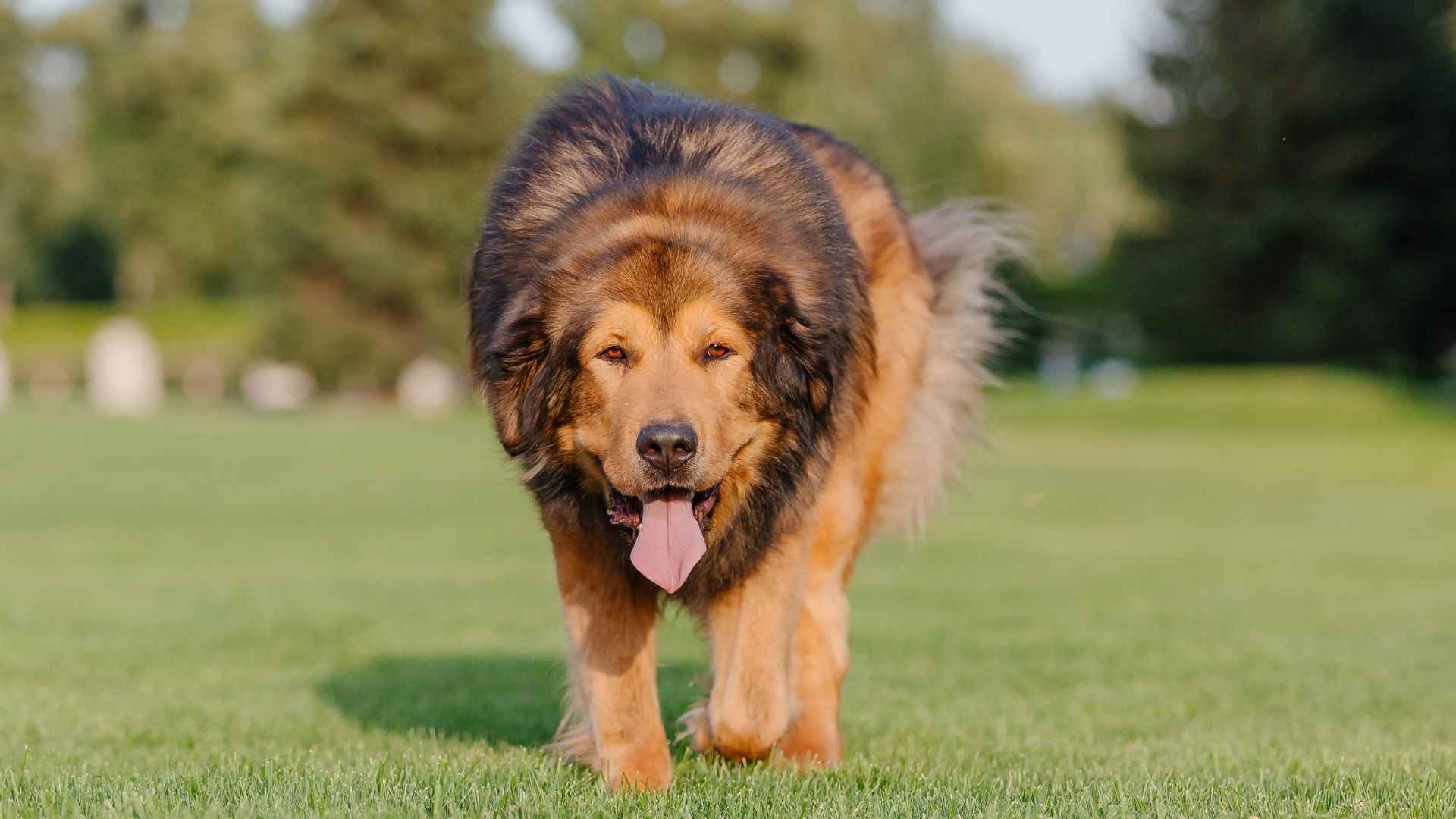When it comes to dogs, size matters—especially when it comes to giant dog breeds. These towering, awe-inspiring canines capture our imaginations with their impressive stature and gentle natures. Though they may take up more space, they often have hearts just as big as their paws.
While many of us might imagine these giants as imposing or intimidating, the reality is often far more heartwarming. These large dog breeds are known for their loyalty, calm demeanor, and loving companionship. Caring for a dog of this size, however, comes with unique challenges and rewards.
From extra-large food bowls to spacious living areas, having a giant dog is a lifestyle choice that demands consideration. If you’re fascinated by these magnificent beasts and wondering if one could be the right addition to your family, you’re in the right place. Let’s dive into what makes these gentle giants so special!
Huge Giant Dog Breeds
1. Anatolian Shepherd
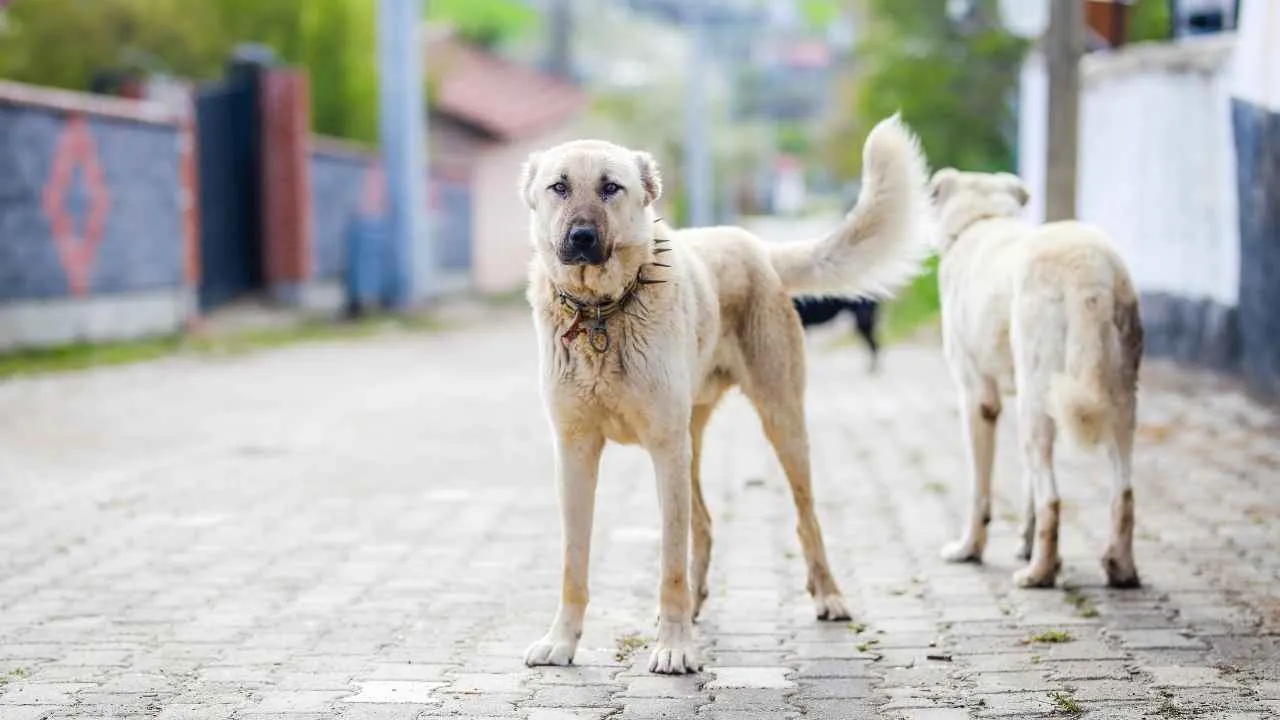
The Anatolian Shepherd is a formidable giant breed renowned for its size, strength, and ancient lineage. Originating from Turkey’s Anatolian Plateau, this breed was developed to guard livestock against formidable predators such as wolves and bears. With a history spanning thousands of years, it remains one of the oldest and most resilient working dogs.
Anatolian Shepherds are primarily used as livestock guardian dogs, excelling in protecting sheep, goats, and other animals from predators.
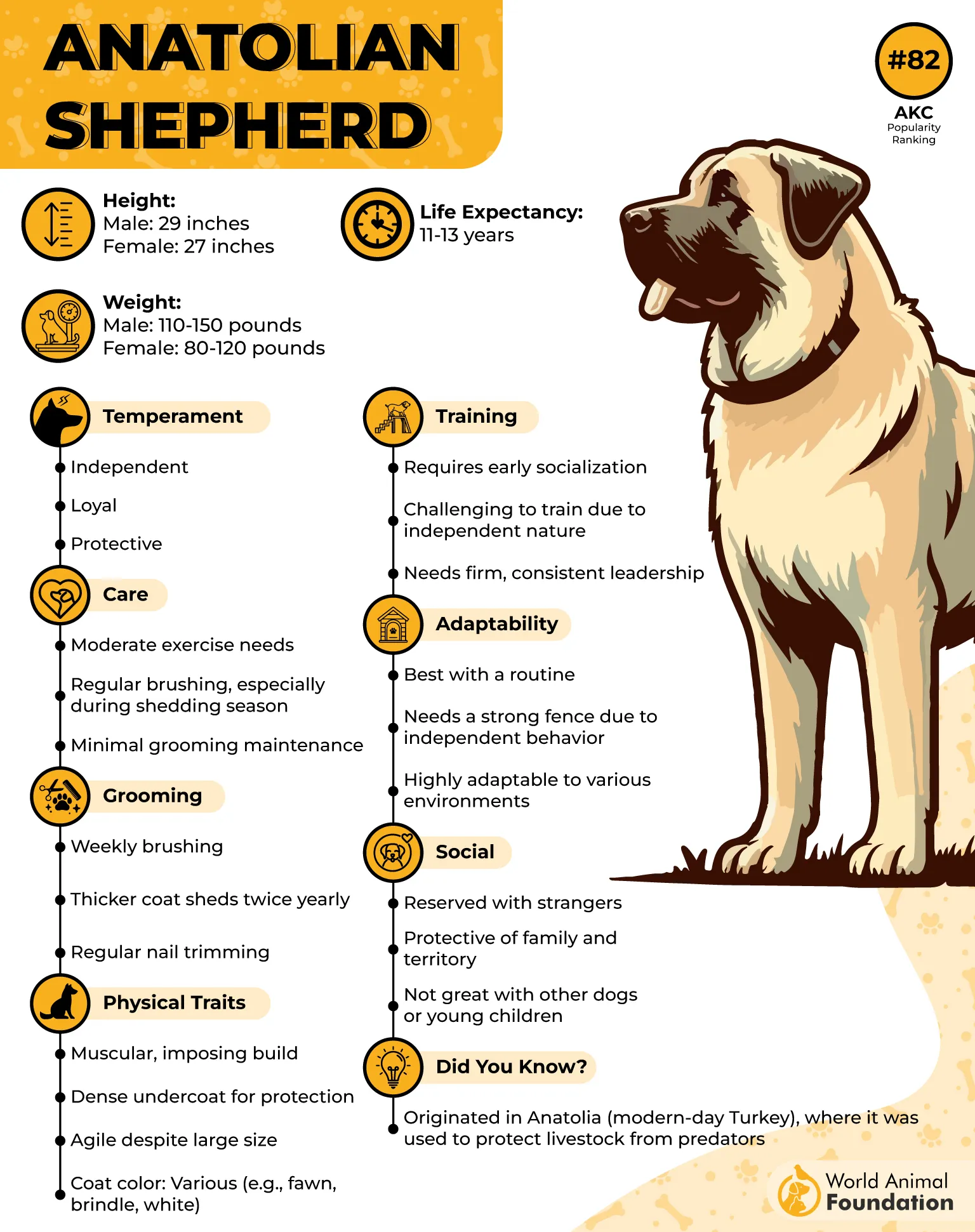
Standing up to 30 inches tall and weighing between 90 to 150 pounds, the Anatolian Shepherd is built for endurance. Its muscular frame and dense double coat provide both power and protection against extreme weather, making it ideal for life in rugged terrains. These dogs are tireless workers, bred to patrol and protect without supervision.
Despite their commanding presence, Anatolian Shepherds are calm and independent. They form strong family bonds but are naturally reserved, preferring a watchful role over one that demands constant attention. While not overly affectionate or eager to please, their loyalty runs deep, and their protective instincts are second to none.
Quiet and observant, they rarely bark without cause, making them discreet yet effective guardians. Grooming needs are moderate—regular brushing, especially during shedding seasons, keeps their coat in check. Though not high-energy, they benefit from daily walks and open space to roam.
As noted by WebMD, living with an Anatolian Shepherd dog requires experience and leadership. These dogs thrive with firm, consistent training and a defined role. In the right hands, they are devoted protectors and dignified companions—true representatives of the giant breeds.
2. Great Pyrenees
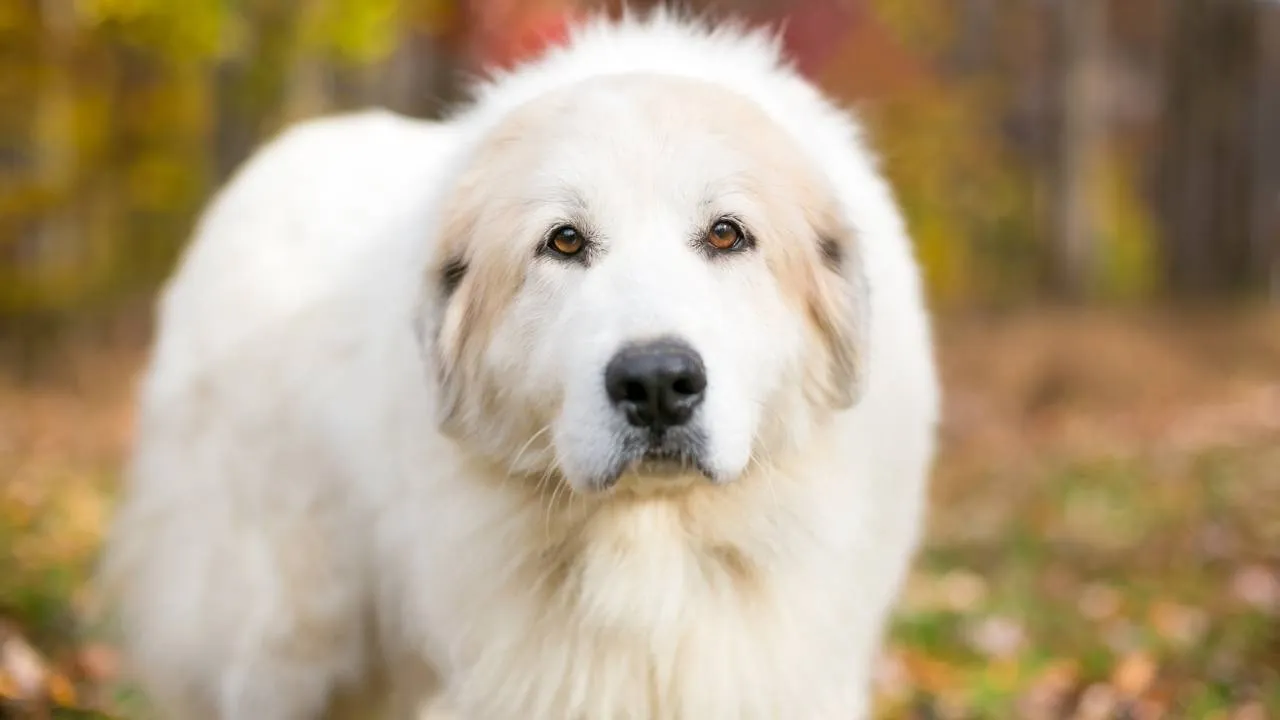
The Great Pyrenees is a noble and time-honored breed, originally developed in the Pyrenees Mountains to defend flocks from wolves and other predators. Their legacy as steadfast guardians is rooted in centuries of independent work, often carried out in isolation, which has shaped both their temperament and instincts.
Striking in appearance, these dogs are best known for their lush white coats and imposing stature. Males typically reach up to 32 inches in height and weigh over 100 pounds, while females are slightly smaller but equally sturdy. Their dense, weatherproof coat was built for snow-covered slopes, and it continues to serve them well in cold or variable climates.
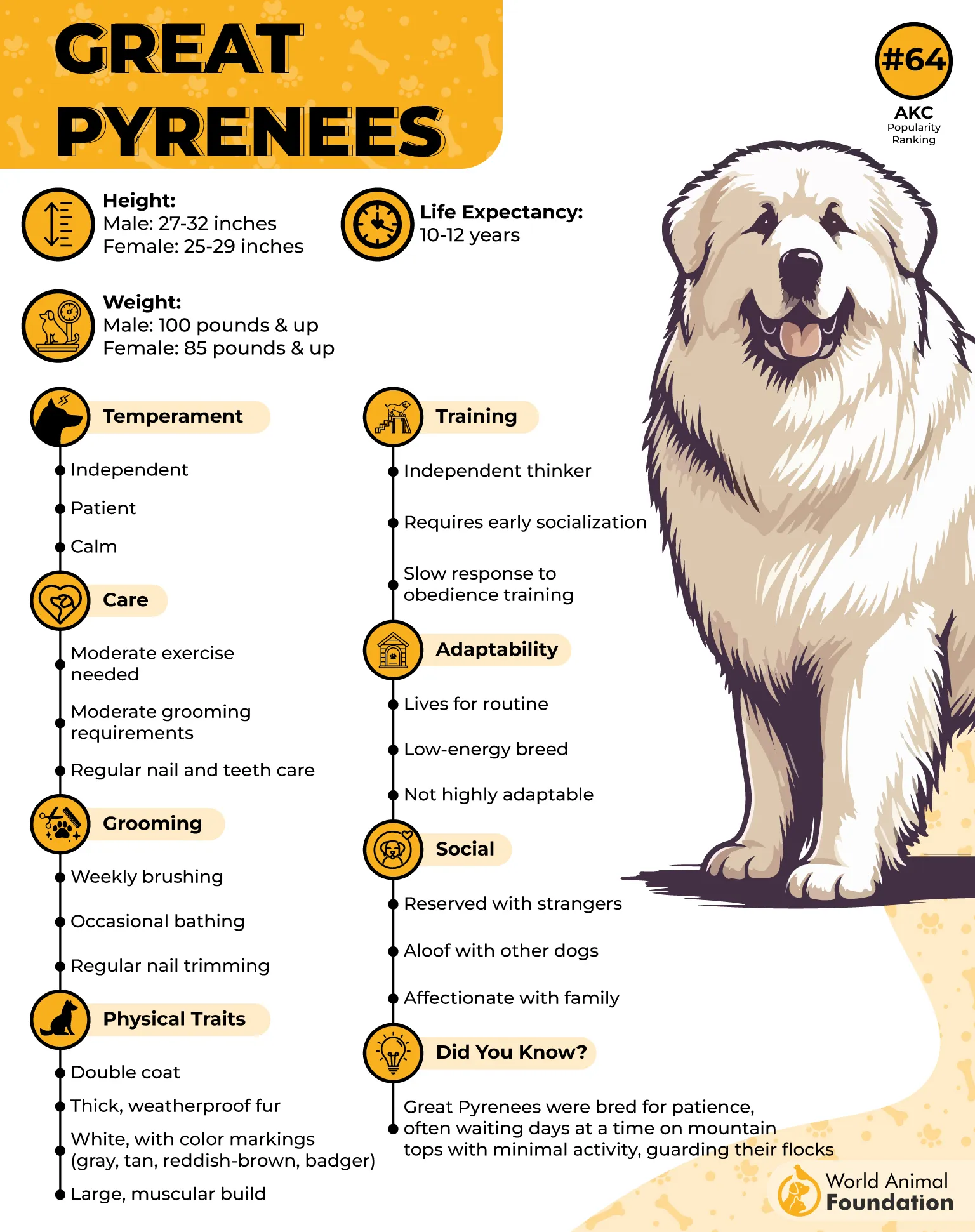
The Great Pyrenees isn’t for everyone, but for those who value calm strength, quiet loyalty, and protective grace, they are more than just a companion—they’re a legacy of guardianship in canine form.
Beneath their grandeur lies a deeply affectionate nature. Great Pyrenees are devoted to their families, gentle with children, and quietly vigilant around unfamiliar faces. They don’t seek attention constantly but are always present, ready to step in when needed. Their calm demeanor often masks a powerful protective instinct.
Training a Great Pyrenees requires patience and respect for their independent mindset. These are dogs that make decisions based on assessment rather than command, which can be a challenge for inexperienced owners. However, with firm, consistent guidance, they learn to balance their autonomy with responsiveness.
3. Irish Wolfhound
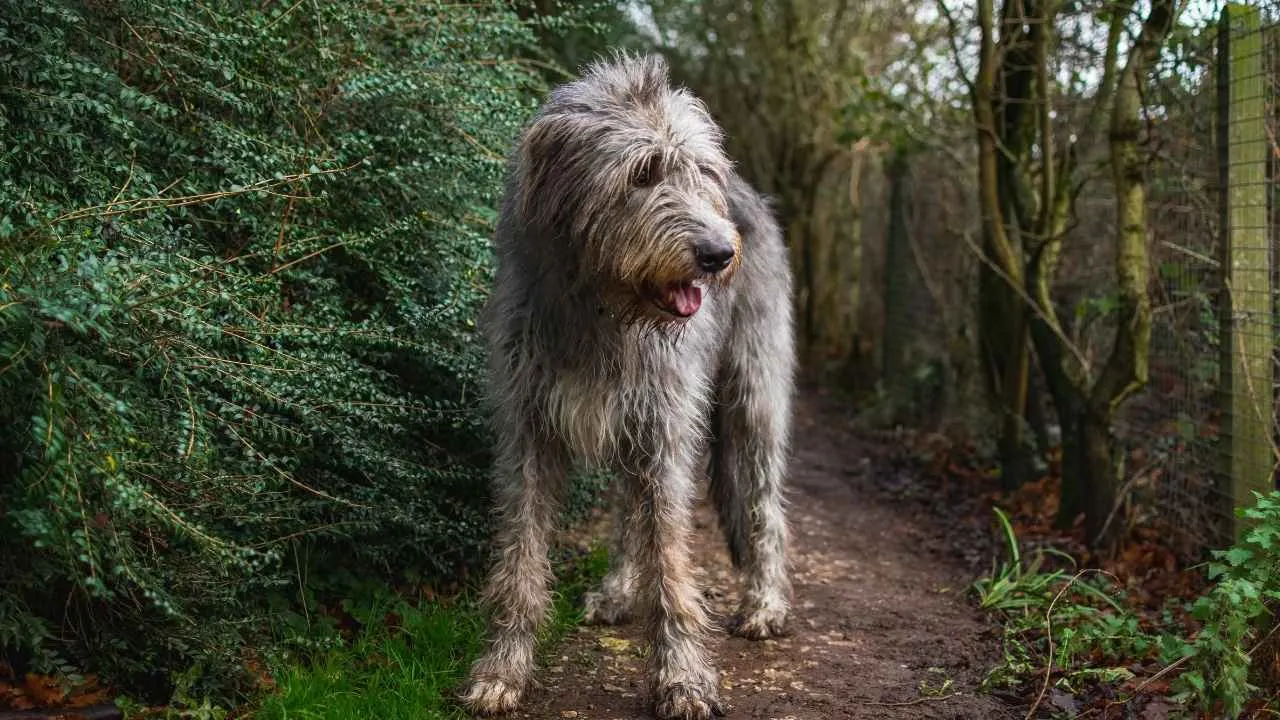
The Irish Wolfhound is the tallest breed, often reaching up to 32 to 35 inches at the shoulder. Bred originally in Ireland for hunting wolves and large game, this ancient sighthound combines grace and power in equal measure. Their towering height and lean, muscular build give them a commanding yet noble presence.
Despite their intimidating size, Irish Wolfhounds are famously gentle and friendly. They possess a calm, even-tempered nature, often described as dignified rather than dominant. Their affectionate disposition makes them excellent family companions, especially in homes that can accommodate their size and relaxed pace.
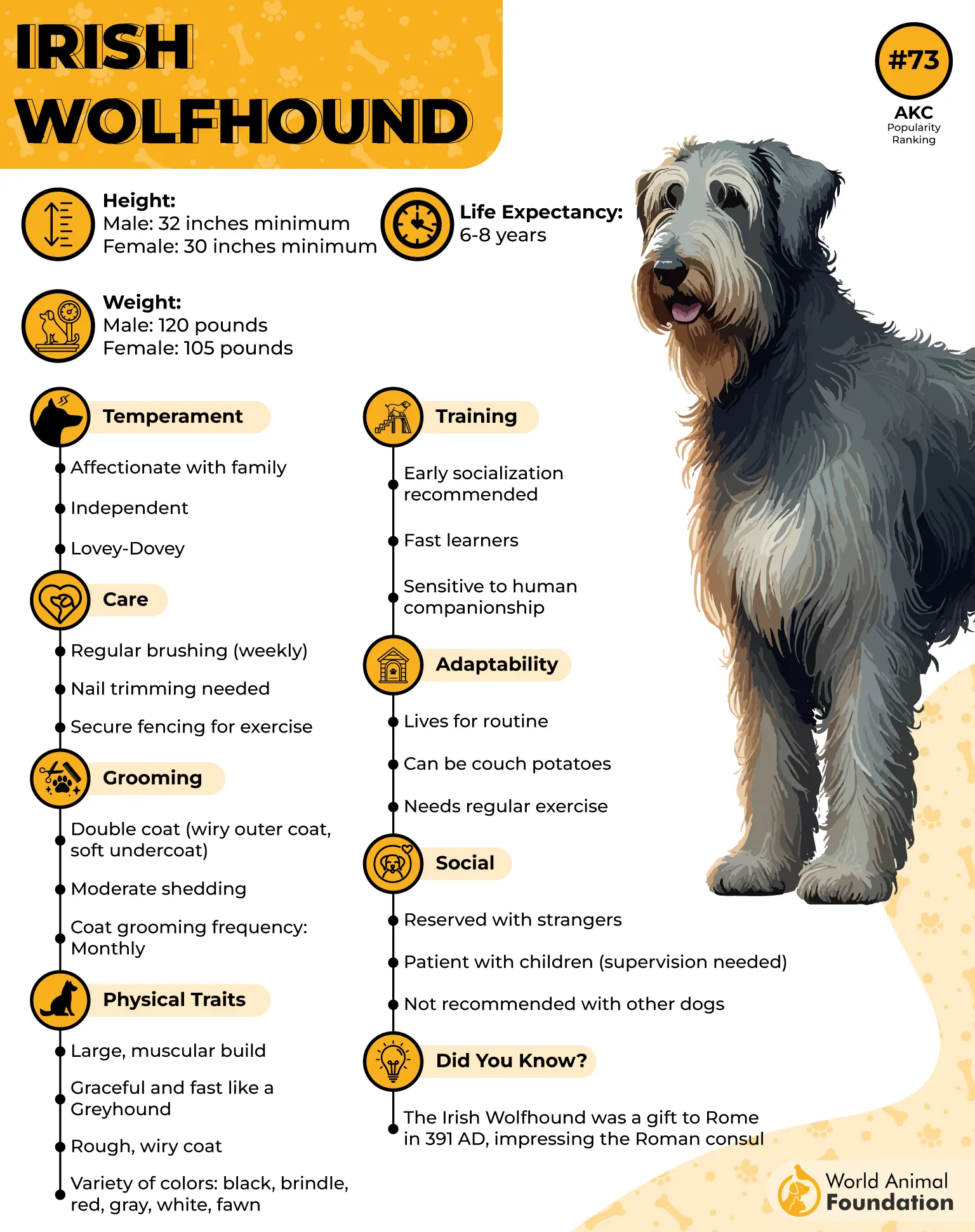
As noted by Hillspet, their working history goes back centuries, where they served as hunting dogs and later as symbols of nobility and guardianship. While no longer used for hunting wolves, their endurance, alertness, and loyalty remain hallmarks of the breed. Today, they thrive as companions, therapy dogs, and show dogs, admired for their majestic stature and mild personality.
Grooming an Irish Wolfhound is relatively low-maintenance, thanks to their rough, wiry coat. Regular brushing helps manage shedding and keeps their coat tidy. Although they don’t require intense grooming, their size means even routine care, like nail trimming or bathing, takes time and space.
Living with an Irish Wolfhound means embracing a gentle giant that brings quiet companionship and quiet grandeur. They bond deeply with their families, are tolerant of children, and display an old-soul wisdom that’s hard to match. For those who appreciate serene strength in a supersized frame, the Irish Wolfhound offers exactly that.
4. Leonberger
The Leonberger is one of the biggest dog breeds, standing up to 32 inches and weighing between 90 and 170 pounds. This towering breed was originally bred as farm dogs to protect livestock, and its size and strength made it ideal for such a role. Their robust frame and thick, weather-resistant coat are perfect for harsh climates.
Its majestic lion-like mane adds to its regal and powerful appearance. This feature, combined with its massive frame and thick double coat, contributes to the breed’s reputation as one of the most majestic and noble-looking giant dogs.
Leonbergers form strong bonds with their families. They are particularly great with children and enjoy being involved in family life, displaying loyalty and affection despite their imposing size.
Adapted to cold weather, the Leonberger’s thick double coat requires weekly brushing to maintain its health and prevent matting. Their dense fur was originally designed for mountainous regions, providing insulation against the cold, but it also means they need regular grooming to keep their coat in top condition.
Hillspet states Leonbergers should be provided with proper training and socialization from early age. They are strong and independent, so consistent, positive training is key to ensuring they grow into well-mannered companions. Regular exercise is important for their health, with daily walks and activities helping to keep them fit.
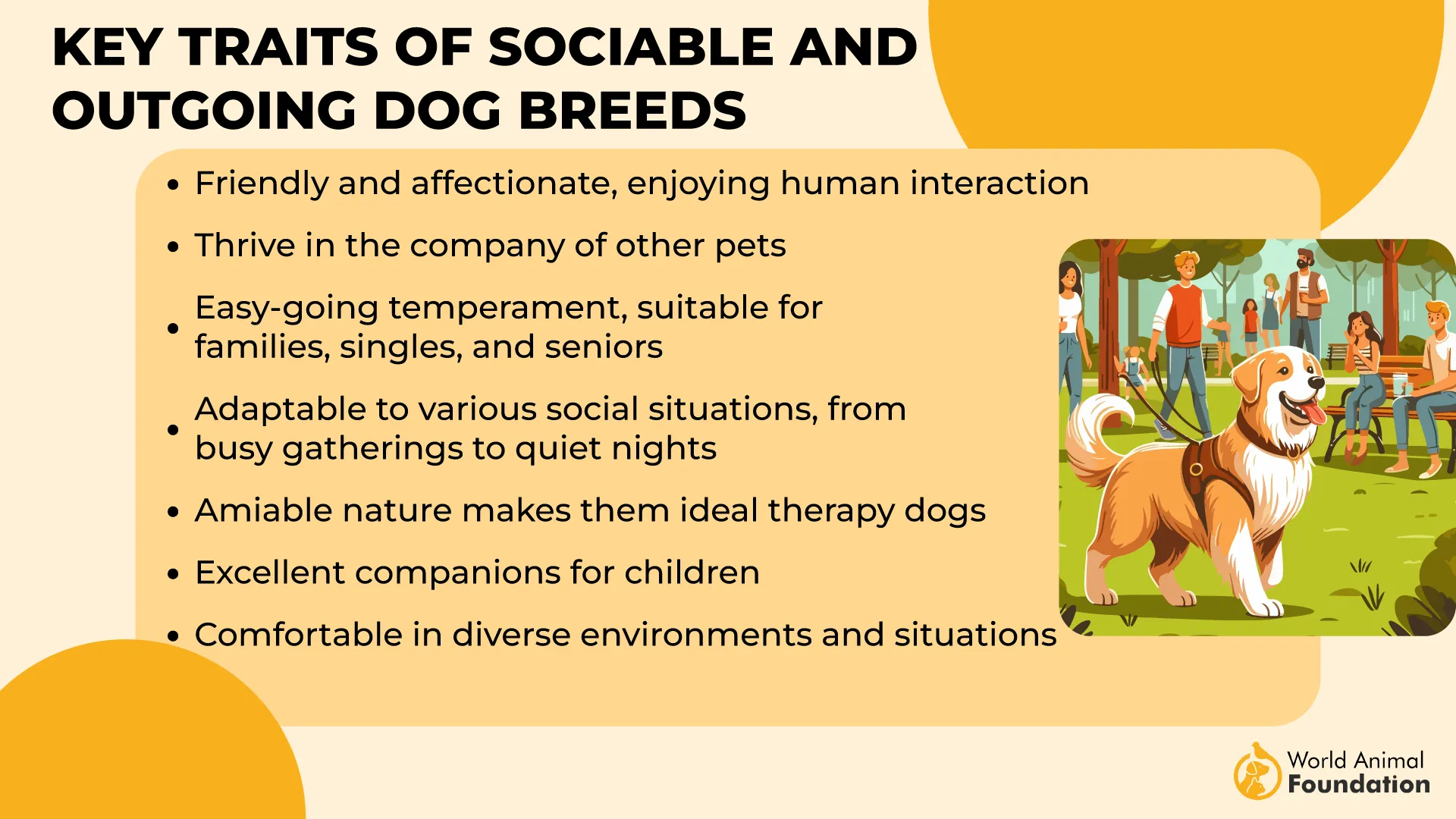
Leonbergers are prone to hip dysplasia, heart conditions, and other joint-related health concerns. Their average life expectancy ranges from 8 to 9 years, making proactive care essential. Regular veterinary checkups, a balanced diet, and controlled exercise play a key role in maintaining their health and quality of life.”
While big dogs like the Leonberger need enough exercise and space to thrive, their strong sense of loyalty and protective nature make them wonderful companions for families who can provide the time and attention they need.
5. English Mastiff
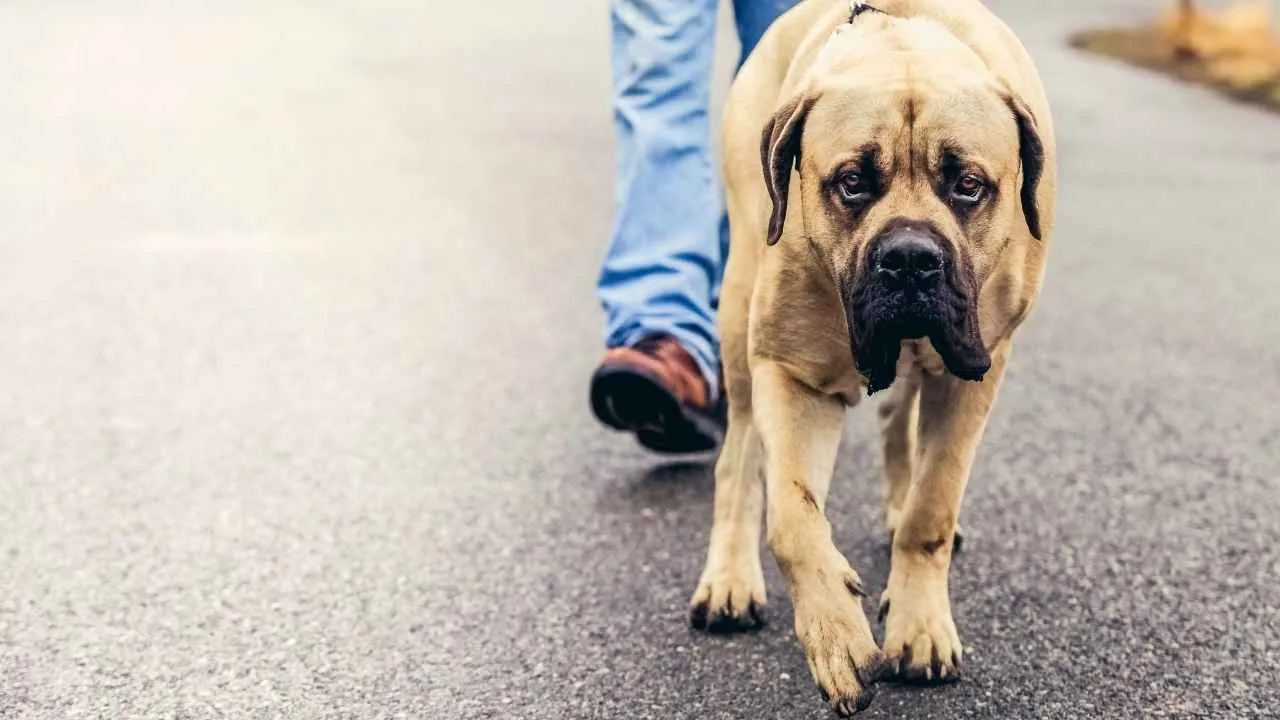
The English Mastiff is a majestic breed renowned for its size and regal presence. Originally bred in ancient England to guard estates and livestock, these dogs are strong protectors. Today, they are beloved family companions, known for their gentle and affectionate nature despite their imposing size.
Males typically weigh between 120 to 230 pounds and stand up to 30 inches at the shoulder. Their broad, muscular build and short, dense coat come in various colors, including fawn, brindle, and apricot, with a signature dark mask. This appearance reflects their role as guardians, balanced by their calm, family-oriented demeanor.
While English Mastiffs are low-energy and content with moderate daily walks, their large size makes them prone to health issues such as joint problems, heart disease, and obesity. Managing their diet and weight is essential to prevent complications, especially with joint strain.
Though intelligent, English Mastiffs can be strong-willed, requiring consistent and patient training. Early socialization and guidance help them become well-behaved companions. Their protective instincts, when properly directed, make them reliable guardians without aggression.
Despite their size, English Mastiffs are friendly and sociable, getting along well with children and other pets. Their calm and loyal nature makes them ideal family dogs, thriving in environments where they receive love and care.
6. Newfoundland
The Newfoundland originated in Canada, where it was bred to assist fishermen by pulling nets, hauling boats, and performing water rescues. Their strength and swimming ability made them invaluable workers in maritime communities.
Weighing between 100 to 150 pounds and standing up to 28 inches at the shoulder, Newfoundlands are massive yet agile swimmers. Their thick, water-resistant coat and webbed feet make them well-suited for water-related tasks.
Known as “gentle giants,” Newfoundlands are calm, affectionate, and patient, especially with children. They are often referred to as nanny dogs due to their natural ability to care for and protect young ones. Their loyalty, easygoing nature, and protective instincts make them ideal family companions.
Although friendly, Newfoundlands are independent and respond best to positive reinforcement training. They enjoy companionship but are content to relax and observe when not engaged in activities.
Newfoundlands require moderate exercise, including daily walks and swimming, but their large size makes them prone to joint issues like hip dysplasia. Regular veterinary care and weight management are important for their health.
Their thick coat needs weekly brushing to prevent matting, especially during shedding seasons. Despite their size, they adapt well to family life, thriving in homes with space and attention.
7. Saint Bernard
The Saint Bernard is a colossal breed known for its impressive size and gentle nature. Males typically weigh between 120 to 180 pounds and stand up to 30 inches tall, placing them among the largest breed dogs.
Their powerful, muscular frame, combined with a thick, water-resistant coat, reflects their original purpose as mountain dogs in the Swiss Alps, where they were bred for rescue missions in harsh, snowy conditions.
Despite their towering stature, Saint Bernards are friendly dogs, particularly with children. Their calm, patient demeanor makes them excellent family companions. They are not only big in size but also in heart, always ready to protect their loved ones with unwavering loyalty. Their droopy face and warm eyes add to their endearing, patient nature.
They tend to be less energetic, preferring moderate exercise like daily walks or time spent in a secure yard. Despite their large size, they are generally not demanding and enjoy lounging after exercise, making them well-suited for homes with space.
Saint Bernards are intelligent, but their independent streak means training requires patience. They approach tasks slowly and deliberately, responding best to positive reinforcement methods.
Saint Bernard’s combination of size, intelligence, and gentle temperament makes them particularly unique. They are not just massive dogs—they are loving, loyal companions who thrive in family settings, always ready to provide protection and affection.
8. Scottish Deerhound
The Scottish Deerhound is a dignified and graceful breed, often described as the “Royal Hound of Scotland.” Known for its long, flowing coat and elegant stature, this breed was originally bred to hunt large game, such as deer, in the rugged Scottish Highlands.
With a height of 28 to 32 inches at the shoulder and a lean, muscular build, the Scottish Deerhound is built for speed and endurance, capable of running at incredible speeds to chase down game.
They have a quiet, reserved temperament and are often described as being particularly good-natured. These dogs are known for their affection towards their families and tend to form strong bonds with their human companions. They are also friendly with other dogs, though their instinct to chase smaller animals may require supervision.
AKC states Scottish Deerhounds are intelligent and independent. Their affectionate nature makes them eager to please, though they do tend to follow their instincts when outside, which is why early training and socialization are important. With proper guidance, they grow into well-behaved and dependable companions.
Grooming the Scottish Deerhound is relatively simple. Their wiry coat doesn’t require much maintenance, though regular brushing is needed to remove loose hair and prevent mats. They are moderate shedders, and their coat helps protect them from the harsh elements, making them well-suited to colder climates.
Regular outdoor activity, such as a few short runs or long walks, keeps them physically fit and mentally stimulated. They are generally low-energy indoors but enjoy spending time with their family when not out running.
9. Tibetan Mastiff
The Tibetan Mastiff is a commanding giant breed, reaching up to 30 inches in height and weighing between 70 to 150 pounds. Bred to withstand the harsh Himalayan climate, their dense coat and imposing build were tailored for guarding livestock. A thick mane around the neck enhances their lion-like appearance, adding to their formidable presence.
Originally developed to protect flocks from predators such as wolves, they remain natural guardians. With strong instincts and an independent streak, Tibetan Mastiffs excel in roles that demand vigilance. Though not overly active, they require daily exercise and mental stimulation to maintain balance and health.
Beneath their powerful exterior lies a calm, deeply loyal dog. They bond closely with family yet remain cautious around strangers. Early socialization is essential to help them navigate unfamiliar situations with confidence and control.
Training this breed demands consistency and patience. While intelligent, they are known for their stubbornness and independent thinking. Positive reinforcement and clear leadership are key, making them better suited for experienced owners.
Their thick coat needs regular grooming, especially during seasonal shedding, to manage tangles and maintain cleanliness. Despite their size, they are surprisingly content with a calm environment and moderate activity.
A true giant breed, the Tibetan Mastiff stands out for its strength, independence, and unwavering loyalty. With proper training and care, they become devoted companions and formidable protectors.
Conclusion
In the world of canines, giant dog breeds stand apart not just for their size but for their loyal hearts, protective instincts, and impressive intelligence. Breeds like the Bernese Mountain Dog and Great Dane exemplify how these gentle giants balance strength with affection, especially around kids.
Many, such as the Cane Corso, French Mastiff, and Neapolitan Mastiff, have long served as reliable guard dogs, combining natural vigilance with devotion to their families.
While dogs tend to come in all shapes and temperaments, giant breeds offer something unique—an unmatched presence paired with a calm, often smart demeanor. Breeds like the Black Russian Terrier and Italian Mastiff may be more reserved or even a rare breed.
They’re fiercely loyal and trainable with the right guidance. Their silky coats, drooping jowls, or broad chests might make them look intimidating, but many of these giants are far gentler than small dogs with proper socialization.
Whether you’re drawn to the historic strength of the Dogue de Bordeaux or the affectionate loyalty of a Bernese, giant breeds require commitment—but reward it with unwavering love, protection, and companionship.


